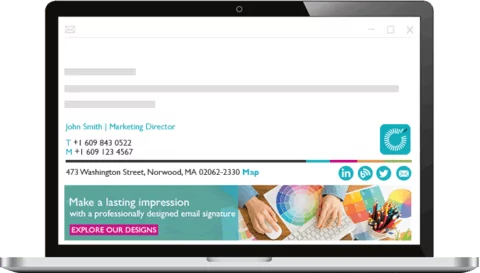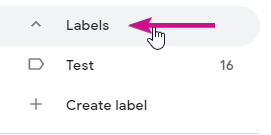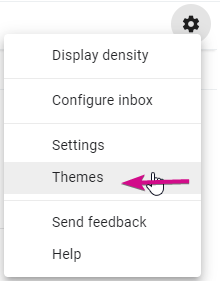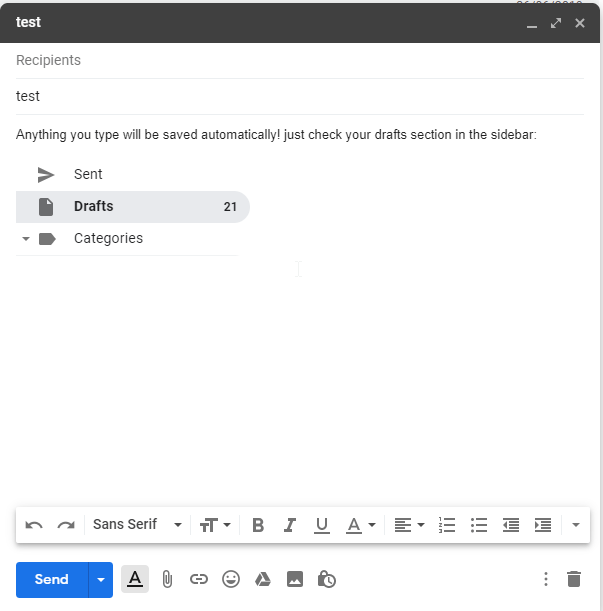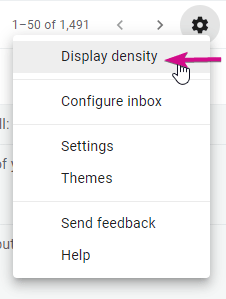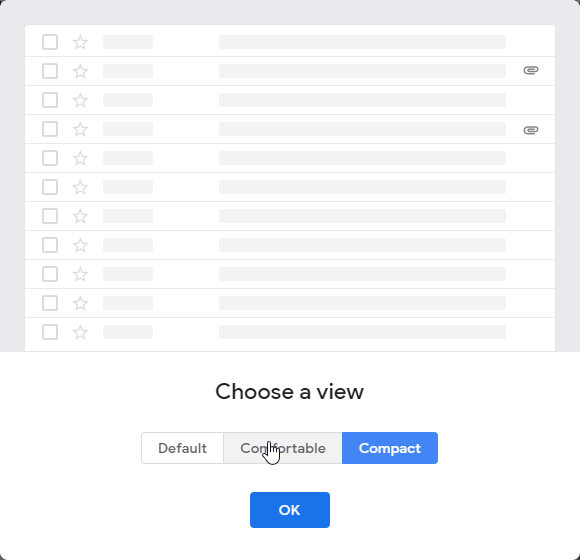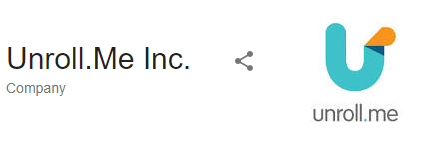
Hacks
1. Bring Priority Emails to the Top
Gmail displays emails in chronological order by default. But, we know that not all emails are the same. Sifting through a handful of marketing mailers just to arrive at that one highly critical and urgent email from your boss isn’t helping your productivity. Try out Gmail’s priority inbox – a feature that filters emails based on what needs your attention the most.
You can activate it by the following steps:
- Navigate to Gmail settings
- Click on the Inbox tab
- Click the “Inbox-type” drop-down and select priority
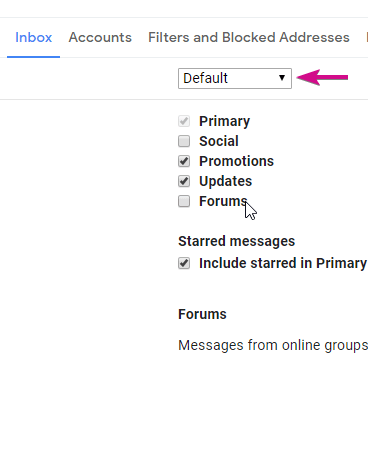
2. Have Gmail tell you what’s important
Based on the type of Emails you open, Gmail can tell what’s important to you and what isn’t. So, here’s what you have to do:
- Head to Settings > Inbox
- Select the Use my Past Actions button
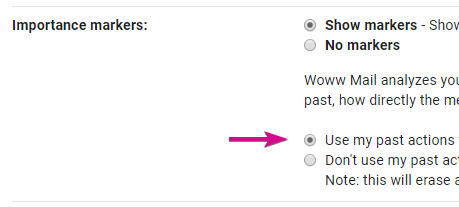
This will get Gmail analyzing your past behavior to figure out what type of mails are priority. Then,
- Choose the Show Markers and the Override filters buttons
- Set the inbox type to Important first
3. Merge your non-Google accounts
It’s a common thing to have email accounts across services. Everyone has at least one personal and one professional account. That said, the back-and-forth between these IDs can get arduous. But the good news is that Gmail has a way to bring all your emails inside a single window – letting you manage all your conversations holistically, from one place.
The best part is that you can respond using any of your email addresses – keeping the necessary separation intact. To enable this do the following,
- Open the Gmail App on your Android phone or tablet.
- Tap Menu on the top right and click Add Account.
4. Create custom email addresses
By default, when you sign up for Gmail with your business, all your email addresses will come with the “@gmail.com” ending. But if you have your own domain name, when you sign up, you can quickly verify your domain name and create new users with your custom domain. The verification process is short and sweet; all you need to do is insert a short HTML tag into your site’s homepage—which you can do even if you’re not an experienced coder. Email addresses that feature a professional domain will be taken more seriously than those with a basic “gmail.com” address, and you’ll get some extra exposure for your brand name, too.
You can do this directly through G Suite:
- Create a G Suite Admin account (if you don’t have one already)
- Sign in to your Google Admin console.
- Sign in using your administrator account (does not end in @gmail.com).
- At the top of the Admin console Home page, click to continue the set up process.””
- Choose one of the following tasks:
- verify your domain.
- activate Gmail.
5. Use Google drive with G Suite
Google Drive is Google’s solution to cloud storage. It allows the saving, storage and sharing of files of any size (up to your account limit). Use the drive icon at the bottom of your email to attach files of any size.
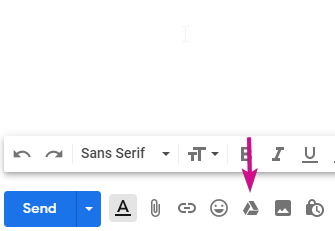
Google Drive is automatically enabled with the basic version of G Suite, so make sure to make use of it’s many features:
- Upload and store files in Drive
- Access your files in Drive
- View and update files in Drive
- Organize and search in Drive
- Access your calendar, notes, and tasks
- Share and collaborate in My Drive
Email Signatures
6. Make a strong impression with a custom signature
Your email isn’t just a tool for messaging. You can use your emails to do some marketing, too. You can design a custom signature for each of the email addresses you manage from your account.
- Under Settings > General
- Scroll down to find the space for your signature creation in gmail and design your signature.
Don’t let this opportunity go to waste! Make sure your signature looks just as professional as the rest of your company branding does. Include a logo (when it makes sense to) or promote an upcoming event, content, or a place to connect on social. Or just give them a way to get in touch or schedule a call with you.
7. Manage your organisations email signatures from one platform
Managing multiple email signatures can be a chore. Will they be consistent across the company? Will employees be tempted to tamper? Will they look good enough? And will they display correctly across different email clients, browsers and devices?
That’s where Rocketseed Email Signature Manager for G Suite comes in. Rocketseed puts you in central control of all your Gmail signatures to ensure brand consistency, makes each signature tamper-proof and gives you professional, responsive design so your signatures always display as desired. And by adding clickable, trackable links, your signatures also become an impactful, engaging marketing channel.
Hacks
8. Create canned responses
Another huge time saver is to make email templates. These are saved or “canned” replies that you can easily add to any email corresondance. To create a “Canned Response” you must do the following:
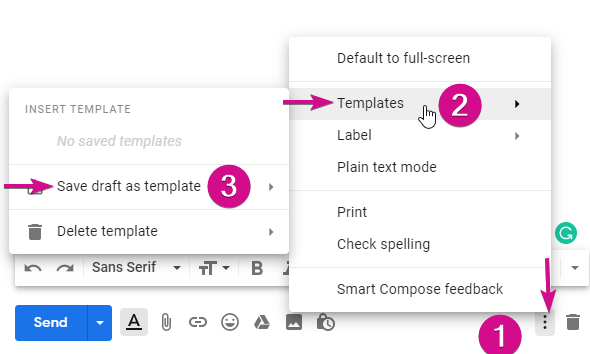
Compose a new email or reply to an existing one.
- Then type out the new email or response you want to use as a canned response.
- Before sending it, click on the More options (little down arrow) in the bottom right corner of the email composition box.
- The click on Canned responses > then New canned response… It will ask you to name it.
- When you are ready to send a canned response simply Compose a new email or Reply to an existing one.
- Then click on the More options arrow and select the canned response you want to use.
9. Use email variants
Gmail doesn’t take dots (.) or plus symbols (+) into account when routing emails. This means all of these are treated the same:
- johnsmith@gmail.com
- john.smith@gmail.com
- john+smith@gmail.com
You can use this to organise your email. You can send johnsmith@gmail.com to clients and john.smith@gmail.com to your service providers, and have an easy way to filter them in your inbox.
10. Enable keyboard shortcuts
Enabling keyboard shortcuts in Gmail is another great way to save yourself a ton of time.
- Go to Settings
- Under the Advanced tab, enable “Enable keyboard shortcuts”
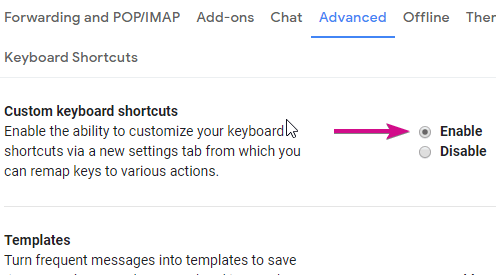 You can also open up the Keyboard Shortcuts tab in Settings after you’ve enabled them to configure your own keyboard shortcuts.
You can also open up the Keyboard Shortcuts tab in Settings after you’ve enabled them to configure your own keyboard shortcuts.
Now when you want to report an email as spam, mute a conversation, compose an email or take any other action, all you have to do is press a button on your keyboard instead of searching for the action button on your screen.
Here are some useful hotkeys:
- “j” to go to older messages
- “k” to go to new messages
- “e” to archive
- “shift + 3” to delete
- “a” to reply all
- “r” to reply individually
11. Use Smart Compose
You can further increase your productivity by utilizing Gmail’s Smart Compose. Gmail’s predictive text feature can sense what you’re typing and complete the phrase or word for you. As you’re typing you’ll see the predictive text in grey, all you have to do to complete the phrase is hit the Tab button.
The Smart Compose feature will save you a lot of typing time, especially if you’re one of those “hunt and peck” typers. This is how to enable it:
- Navigate to Gmail settings
- In the general tab, scroll down to “smart compose”
- Set it to smart suggestions on
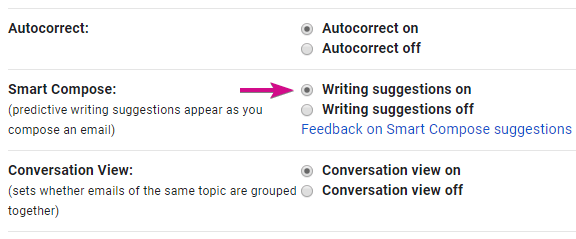
12. Get an unread message notification
When you get a new email in Gmail on your desktop, there’s no fancy “You’ve Got Mail” sound effect to alert you. And you can waste a lot of time and get easily distracted by going back to the Gmail tab throughout the day to see if you have any new emails. So, to increase your productivity, get Gmail’s unread message icon.
- Go to Settings
- Click Advanced
- Look for the Unread message icon setting
- Set it to Enable
- Save Changes.
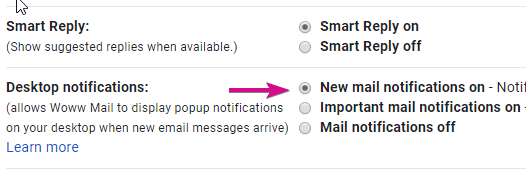
After you’ve enabled the unread message icon, you’ll be able to see the number of your unread messages displayed overtop the Gmail logo on the tab. No more time will be wasted checking your email account, you can just glance at it quickly and keep it pushin’.
13. Create delay so you can undo sent emails
Sending an email to the wrong person can be mortifying. Luckily, there’s a way to avoid this.
To start, you have to turn on “Undo Send.”
To do so do the following:,
- Open up Gmail and in the top right corner click the gear icon then “Settings.”
- There you’ll see a section labeled, “Undo Send”
- Check the box next to “Enable Undo Send.”
- In the “Send Cancellation Period” section, set the amount of time you want to be able to unsend an email.
- After — and most importantly — hit the “Save” button at the bottom of the page.
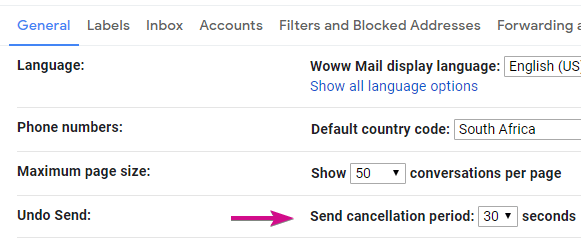
Usually, after you send an email, a box will pop up that says “Your message has been sent.” Now, this box will also feature an “Undo” button.
14. Access Gmail without internet
Turns out, you don’t need to be hooked up to Wi-Fi to check your email. The Chrome extension Gmail Offline allows users to read, respond, search and archive emails without an internet connection.
Before you can use Gmail Offline, you’ve got to turn it on while you’re connected to the internet. To turn on offline mode do the following:
- Log in to your Gmail account.
- Click on the gear icon to open the Gmail menu, then click Settings.
- Under Settings find Offline. Click on it.
- In the Offline menu, click Enable Offline Email.
- Choose how many days to sync, and whether to keep or remove cached email when signing out of a Gmail account.
- Click Save Changes and you’re done.
- Give Gmail some time to download messages, and be sure you have Gmail open in Chrome before going offline.

The extension will take a couple minutes to sync and download your emails before you venture offline.
15. Schedule emails in advance
Sometimes you need to send en email, but now is just not the right time. Gmail’s schedule send feature is perfect for these moments. To do this do the following:
- Compose a new email
- Before you hit send, click the arrow next to send. This will give you an option to schedule the delivery.
- Enter in the time/date you would like the email to be sent, and you are done.
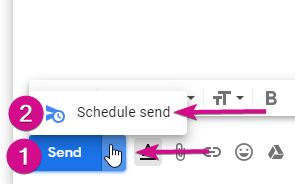
Here’s how Stacey MacNaught from MacKnaught Digital uses this feature in her day-to-day workflow:

Built in schedule send is a dream for me. I do a lot of email responses in evenings. That's because my inbox is quiet in the evenings and I find it much easier to get through emails when there aren't new ones coming in all the time. But the moment you start replying to people at crazy hours, you start inviting responses at those times and you lose your quiet email response time.
Stacey MacNaught - Digital Marketer at MacNaught Digital
16. Unsubscribe from mass emails
Tired of receiving newsletters that you subscribed to years ago? There’s a simple and easy way to unsubscribe to these mass emails.
Every email is required to have an unsubscribe button. Look at the bottom or top of the email and there should be a button that unsubscribes you.

17. Send emails from different addresses
Did you know you can send emails from multiple accounts? To do so do the following
- Click on “Settings” and select the “Account and Import” tab.
- Under the “Send mail as” section, click on the “Add another email address you own” button.
- Add any email addresses you own.
- Next time you go to compose an email in Gmail, you can select which email address you’d like to use from the drop-down menu.
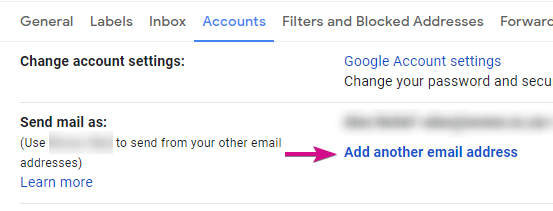
18. Find out if an email was sent to you, a group of people or a complete mailing list
To determine whether that message was directed at you or a mass email list, turn on the “Personal Level Indicator” feature in your account. To do so do the following:
- Click on the gear icon then “Settings” in the top right corner.
- Under the “General” tab, scroll down to find “Personal Level Indicators” and check the box next to “Show indicators.”
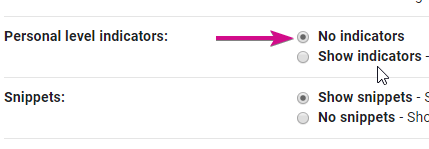
When you go back to your inbox, you’ll now notice single arrows (>) next to an email, which means that email was sent to you and a group of other people. Double arrows (>>) next to an email means that the email was only sent to you. No arrow means the email was sent to a mailing list.
19. Respond to emails at a later date
If you don’t feel like responding to an email right away but you’re worried you’ll forget if you wait — here’s a solution. Add an email to your “Tasks” and you’ll be reminded later to send that response. To add an email to your “Tasks” list:
- Select the email you’re holding off on, then click “More” at the top of the message
- Select “Add to Tasks.”
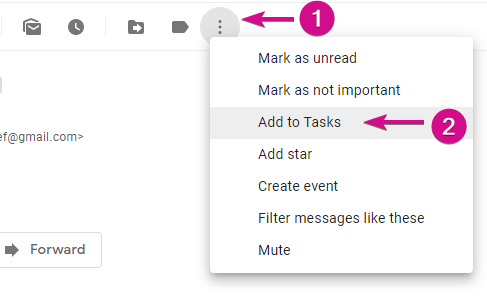
Voila! The email has been added to your “Tasks” list.
To check this list, click the drop-down menu in the top left of your inbox and select “Tasks.”
Here’s what Matt Diggity of Diggity Marketing said about delaying email replies when we asked about his best Gmail tip:

Schedule Your Emails! We all know, in order to maximize productivity, it’s best to batch your work. If you’re going to email, do it once or twice a day, rather than a dozen.
But instantly replying to emails isn’t always a good look. For example, you’ll “train” your employees that they can get instant answers from boss thus they don’t need to solve things on their own. So next time you’re batching you’re email tasks, schedule the unimportant stuff to send a day later. It’ll teach patience and self-reliance on the other end.Matt Diggity - Digital Marketer at Diggity Marketing
20. Import contacts and emails from other email accounts
If you want to consolidate all your contacts and emails into one account — there’s a simple way to do that.
- Go to the gear icon then “Settings” (top right) and go to the “Accounts and Import” tab.
- Click on “Import mail and contacts” and follow the instructions (which vary depending on the email service provider).
In no time, you’ll have all of your info, contacts and mail in one place.
21. After you send an email, have it automatically archived
If you’re looking to clean up your email — and keep it that way — you’ll be happy to know there’s an easy, efficient way to do so. After responding to an email, you can have it automatically archived — where it can then be found in the “All Mail” tab on left menu of your screen, instead of your Inbox.
To turn on “Send and Archive,” do the following:
- Go to the gear icon then “Settings”
- Under the “General tab, locate the “Send and Archive” section and select “Show Send & Archive in reply.”
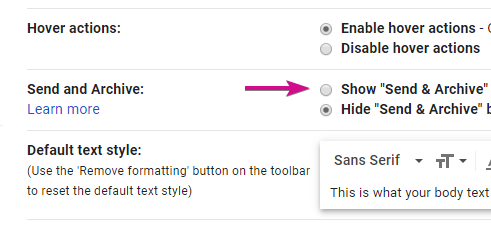

Keeping organised is key, especially with the way the world has recently changed – my email inbox is a priority and using the “send and archive” functionality in Gmail, helps me keep the inbox tidy and up to date, leaving only the emails that still need to be actioned.
Damian Hamp-Adams - CEO at Rocketseed
22. Backup your emails
If you’re concerned about losing important messages, attachments or images, Google provides a link that lets users download their Gmail data. You can download everything on your account, or you can just select certain labels. Your emails are basically backed up for free.
If you’re still skeptical, the web extension Gmvault can back up and store all of your Gmail information.
23. Mute conversations
If you want to tune out of any group conversations, hit the “Mute” button. To find this button do the following:
- Go to the message thread and click the “More” menu.
- In the menu, click “Mute.”
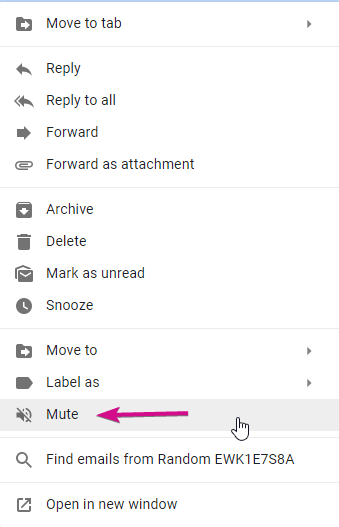
You’ll no longer see this message unless you search for it.
24. Add some emoji to your messages
Emoji aren’t only for texts. If you want to add some fun to your messages:
- Click the menu at the bottom of your message window (this only works on a desktop)
- Select the emoji you’d like to use.

25. Find out if someone was in your account
In an age where your online accounts are under threat, it’s important to make sure they’re secure. To see that no one’s creeping on your inbox, check your “Last account activity.”
- In your inbox homepage, scroll to the bottom and locate — in small text — “Last account activity: X minutes ago.”
- Click “Details” and Gmail will show you every IP address that has accessed your account, and the type of device being used.

26. Use Labels in full color
To speed up your brain’s ability to recognize and select the emails you need, create Labels for your Gmail messages and then set a different color for each label. Once your business emails are labelled in red, your friends and family’s messages in green and your financial transaction receipts in blue, for example, it’ll be much easier to scan your inbox visually and find what you’re looking for. To create more labels, do the following:
- Navigate to Gmail Settings
- Go to the labels tab
- At the very bottom, click the button that says add new label.

27. Showing Maximum Number of Emails per Page
If you are receiving too many emails in a day, then you should definitely explore this option.
It gives you the ability to access more conversations per page.
- Go to settings, click on the General menu bar and scroll down to “ Maximum page size”.
- Thereafter set the number of conversions you want per page.
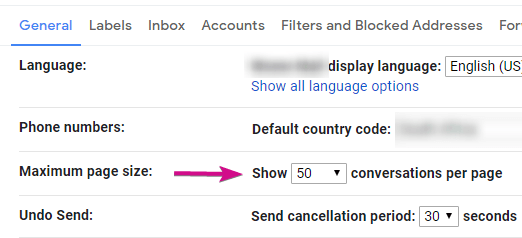
28. Enabling conversation view
If you are a fan of the classic Gmail, this is a handy hack.
To avoid a “thread” view in favor of the old conversation view – just follow these steps.
- Go to the General menu in the setting tab
- Scroll down to the “Conversation View”
- Select the option “conversation view off”.
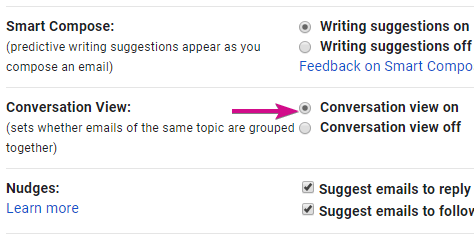
29. Enable desktop notifications
If you live off your emails, then this is a great option. You can simply add a chrome extension of Gmail or go do the following:
- Navigate to Gmail Settings
- Under General look for Desktop Notification and turn it on.

It is also extremely helpful if you have set up email alerts for critical functions.
30. Use Gmail advanced search
You are probably using the regular search feature for your Gmail.
However, with the sheer amount of emails in the inbox, it is difficult to find specific information. This is where advanced search comes in.
- Click on the GMail search bar
- Click the arrow to the far right of the search bar
- Add any filters to specify exactly what you are looking for
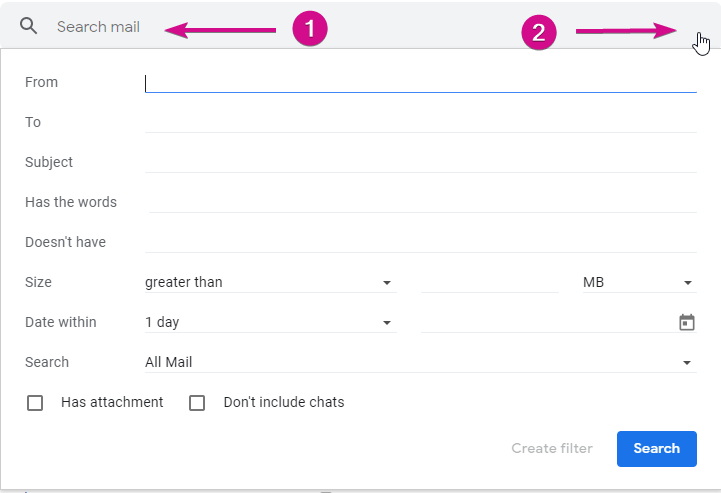
31. Set up a vacation responder when you are away
On leave? Don’t have time to reply to all the email you get? Head to the auto-responder option in Gmail.
You can customize what message you want to send out to people.
- Go to settings
- Click on general tab and
- Scroll down to the vacation responder
- Enter in your custom message
- Hit save
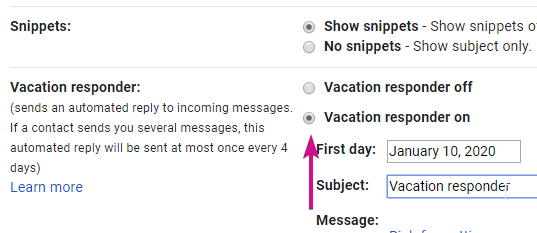
32. Remove strange formatting from text
How annoying is it when you paste some text from a web page into your email, and it brings all the formatting with it? Or when you change the font size and style only to hit send and see in your sent items that the formatting was still off?
Worry no more! There’s a little-known button in Gmail which removes the formatting without the need to use a Text/Edit pad.
- Copy the formatted text to an email
- Select the text you want to clear
- Click the arrow on the far right of the toolbar
- Click the top icon, “clear text formatting”
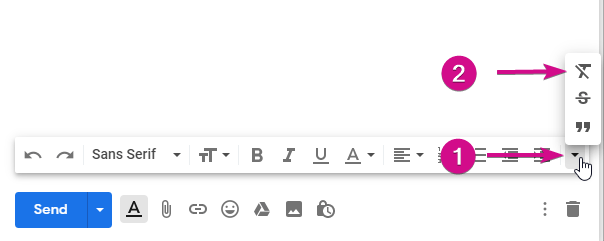
33. Create Contact Groups and Send to Many at Once
If you ping emails to the same group of people on a regular basis, set up contact groups.
That way you just need to type the group name into the ‘To’ field rather than typing in every single email address.
Marketing Tip: You can also export the email addresses from your groups. Good to know if you want to use them for email marketing or a Customer Match campaign on Adwords (you must have more than 1000 emails in your list for the latter).
Set it up:
- Click the Grid next to your account
- Look for “Contacts”

- Click create new label

- Add any relevant contacts to this label
- Now, when you compose a new email to this group, type that label name, and everyone in that label will receive that email.
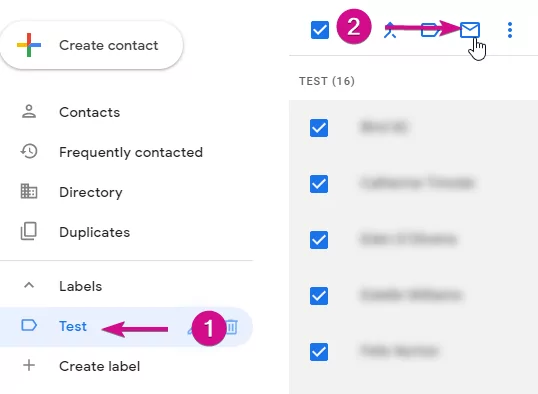
34. Set up Gmail on Your Phone
Depending on the phone you have, you could either add Gmail in the Mail settings or download the Gmail app.
I often start the day by opening Gmail on mobile and sifting through and filing away the things I don’t need to reply to. That gives me some time to think about how to attack the more time-consuming Inbox arrivals.
You can find the Gmail app on the Playstore, or the Appstore depending on your device.
35. Enable a theme
Okay, so this one’s not much of a Gmail hack, but it makes staring at your inbox all day a little more bearable.
Choose a theme like a beautiful sunset, a wild woodland, a crazy cat or one of your own images (keep it clean).
Anything to inspire you to achieve Inbox Zero on a daily basis.
Style it up:
- Navigate to the cog

- Click Themes
- Pick Your Theme
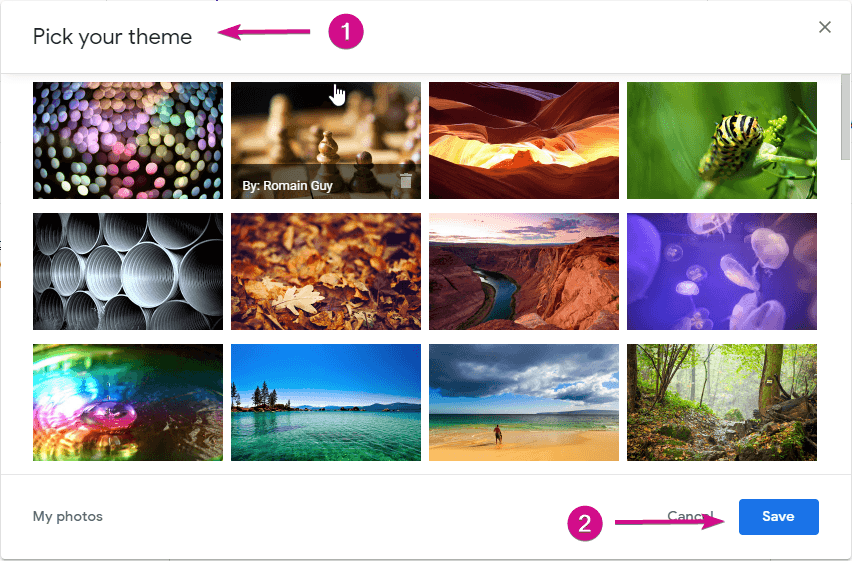
36. Search your attachments
If you’re hunting for an email that had an attachment, theres a way where your search will only pull up emails with attachments, so you don’t have to wade through a sea of empty messages.
- Type your search query in the saerch bar
- Add “has:attachment” to the search query

37. Have a faster loading gmail
If you need to check your email right this minute, but it’s taking a while to load, switch over to the service’s basic mode.
- Open Gmail
- Add this to the URL: “/?ui=html” without quotes
By adding “/?ui=html” to the end of your url (using mail.google.com), it loads the version without Java Script.
![]()
However, that means many of your modern Gmail features won’t function, but it will pull up your email in a shorter amount of time and allows you to employ basic actions.

38. Enable email snippets from Google Inbox
While Gmail compares snippets to previews you see for web pages in Google search, it’s not really the same thing as the one in Google Inbox.
Depending on the length of the subject line, you might not see much at all of the snippet. Even then, will it help you decide whether or not to open the message now or later? That’s for you to decide.
- Navigate to settings
- Under the General tab, enable (or disable) snippets
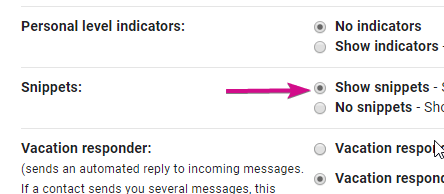
If you find the additional snippet text unnecessary or even overwhelming, disabling this option is probably best for you.
39. Explore the right-click button
Just like anything else, the more emails and folders you have in Gmail, the longer it takes to do things like move a file from the inbox to a folder that’s deeply buried on the sidebar.
You can bypass all of that hunting around by using the right-click function:
right click in gmail
Right-click isn’t just useful for moving or labeling files. You can instantly reply and forward messages, snooze them until you’re ready to deal with them, or open them in the browser.
Just try right clicking your emails and see what options are available.
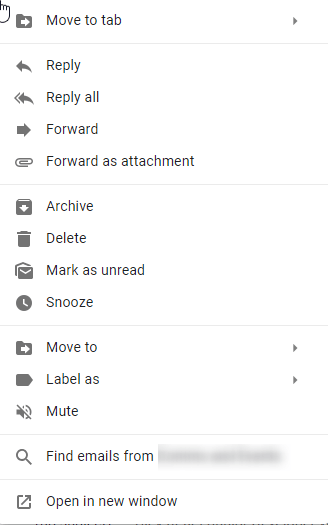
40. Make Gmail speak your language
If you’d like to use a different language than the default one Gmail has assigned you, you can
- Change this under Settings > General:
- Gmail language settings
- Simply choose the new language you want Gmail to display your messages in.

Note, however, that this will change the language settings across all your Google products. If all you need to do is translate a message on a one-time basis, look for an add-on to do it for you.
41. Allow someone else to manage your account (temporarily)
You’ve got to go on vacation or take a sick day at some point, right? If you want to hand control of your inbox over to an assistant or coworker during that time, Gmail makes it easy to do.
- Navigate to Settings
- Under the Accounts and Import tab, you’ll find the option to grant access to someone else:
- Select grant gmail access
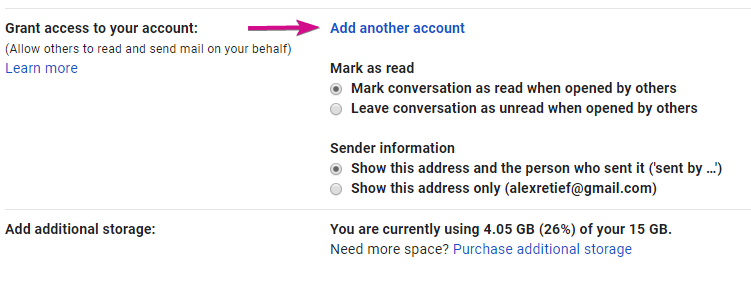
This allows another user to manage your email account on your behalf.
You can also set a rule for marking messages as read or unread. You’d use this, for example, if you’re giving a coworker access when you’re out sick—you might want to leave conversations unread so you can reference what was done when you return.
Or maybe you’ve hired a virtual assistant and want them to fully manage your inbox. It would be a hassle to always leave everything unread. Just trust them to do what they need to do and let them be marked read.
42. Take advantage of drafts
If you’ve ever accidentally closed out your Gmail tab while writing an email, you’ve been coincidentally saved by the automatic Draft feature in Gmail. Gmail will save whatever emails you’re working on in a designated Drafts folder, for your future editing and perusing needs. You can utilize this Draft system for anything, from working on future emails you’ll need to send to saving some of your work in a format that’s instantly ready to convert to email.
-
- Compose an email

- Write/attach anything in the email that you want to save for later.
- Search your drafts later to find it again
- Compose an email

43. Mark emails specifically so Google can learn how to filter them
By default, Google will use your past behavior to learn your preferences; it may notice that you typically star emails that contain certain keywords or are addressed to you in a specific way. You can toggle this feature off in Settings, but it’s there to help you. Marking your emails in a consistent fashion will help “train” Google to automatically mark and sort your emails according to your own standards and wishes.
This only works if you have this setting enabled. Enable it in the following way:
- Go to settings
- Under the Inbox tab, look for “Importance markers”
- Enable the setting that says ”Use my past actions to predict which messages are important to me.”
- Hit save
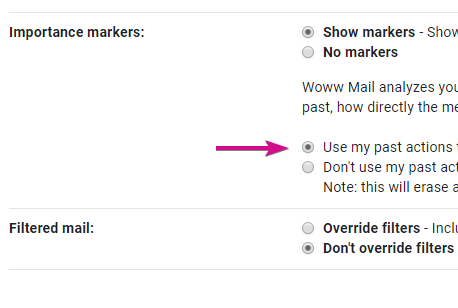
When we reached out for some Gmail tips from Justine Jordan, Head of Marketing at HelpScout, she mentioned this feature as one of her favourites:

Gmail has many features that make it easier and faster to find the messages you’re looking for. You can train Gmail to place different types of emails in the Primary, Social, Promotions, Updates, and Forums categories by dragging messages from one tab to another. Over time Gmail will learn to consistently place similar messages in the categories you specify so you can anticipate where to find emails in the future.
Justine Jordan - Head of Marketing at HelpScout
44. Use full screen for writing emails
By default, Gmail gives you a small window in the corner of the screen for composing new messages. If you’d rather write in a centered and more full-screen field, there is an option to enable it temporarily:
- Compose a new email
- Find the small diagonal arrow in the windows upper-right corner

Alternatively you can set it to be the default setting for writing emails:
- Click the three-dot menu icon in the compose window,
- Select “Default to full-screen.”
That’ll make all your future emails start in that large, centered view.
45. Block people you don’t want to receive emails from anymore
Gmail has a sophisticated spam filter, which should protect your inbox from most junk mail. However, there are many reasons to block a legitimate sender, especially if the sender has become obnoxious or abusive.
- Open an email from the person you want to block
- You will find the three vertical dots near the top-right.
- Open this and click on “Block ____.”
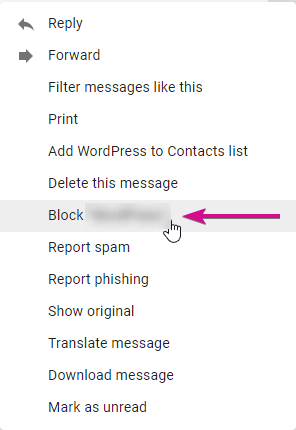
Click this option to deflect all messages dispatched by this sender.
46. Create emails that self destruct
Gmail has developed a custom software script that hosts a self-destruct feature. Using this can add a timer to your mail and it will be self-destructed after a certain interval of period.
This helps when you don’t want an email to be forwarded to someone else.
- Click on the padlock icon near the send button before you send out the email.
- A new tab named Confidential mode opens with the option of Set Expiration.
- Make the necessary changes here.
- Click send
- The email will come with a warning to the receiver that lets them know the email will not be available after the given date.
47. Send password protected emails
The confidential mode discussed above also allows you to send an email with a verification encryption sent via SMS to the recipient.
This will enable you to build an additional coating of security to your mail. Using this feature, you can be sure that the mail is read by the intended recipient only.
A reliable SMS Gateway plays a critical role in this process, ensuring that verification messages are delivered promptly and without errors, supporting a seamless and secure communication experience.
48. Setup Gmail account recovery
I get at least one email a day that is spam that tries to hack into my account. So for security purposes, do update your account recovery options. This will be helpful when you are unable to remember your password or have been hacked.
It is just a series of questions you need to set up while opening the account (or update later on).
Additional tip: You’d need to remember the answers. So choose something you have negligible chance of forgetting or getting it wrong.
Clean Up Your Gmail
49. Disable Chat
If people have forgotten anything about Gmail, it’s the Hangouts feature. It was quite useful when it first came out but there are just so many messaging apps out there today that users are spoilt for choice.
So, why not just disable it? In case you didn’t know, Hangouts does slow down your Gmail. You can disable it in the following section in Gmail:
- Open your gmail settings.
- Under the Chat section, set Chat to off.

50. Audit connected apps and services
With all the benefits of using apps and tools in Google, we don’t think twice about granting access to our Google accounts. Just be aware that having too many apps can make Gmail sluggish because all of these compete for your account’s data resources.
It’s a good idea to audit your apps from time to time or if Gmail slows down:
- Visit the IssuedAppSubTokens page to manage the list of apps connected to your Google Account.
- Revoke access to any service you no longer need
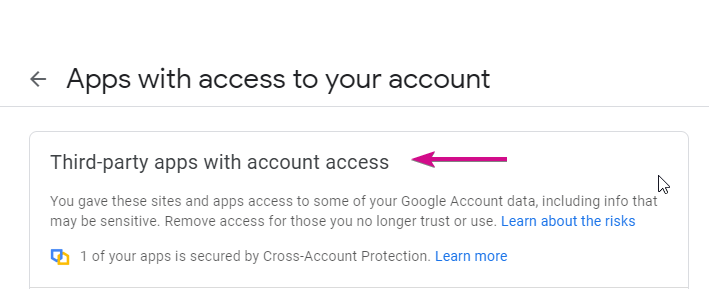
51. Do away with Filters you don’t need
While Gmail filters are the good guys helping you manage emails, they come with a trade-off: they slow down your Gmail, especially if you accumulate an unwieldy collection of filters, most of which you don’t even need! What you should do:
- Head to Settings and then Filters and you have a list of filters to review.
- Run a careful analysis of all the filters you have and remove the ones that are no longer relevant. You’d be surprised by the number of filters that have become irrelevant!
52. Create filters that you do need
Are you tired of manually marking emails as important or having to delete emails constantly? If you are, create a filter to do the work for you. Using filters in Gmail is like having your own personal assistant to take care of your inbox!
With filters in Gmail you can filter mail by from, to, using certain keywords, by attachment size or date. You can get Gmail to automatically delete all emails from a certain sender or automatically mark all emails with certain keywords as important for instance. To create a filter:
- Go to Settings > Filters and Blocked Addresses > Create a new filter
- Then choose your filter criteria and what action you want Gmail to take.
- When you’re finished click the Create filter button.
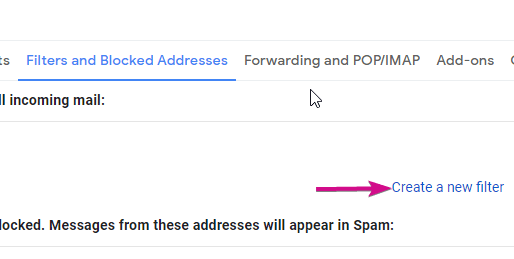
Here’s a tip Cody Jones has for Gmail that uses the powerful filter functionality built into Gmail:

My #1 tip for Gmail (used or ignored daily) would be the following - set a rule to automatically route any emails with an unsubscribe link to a particular folder, which is reviewed every two weeks. It allows me to focus on real emails versus potential spam. Thanks!
Cody Jones - Head of Partnerships at Zapier
53. Always use the Default Theme
There is no shortage of glitzy themes on Gmail. But, the sad part is that all these themes do more damage than you’d expect. Owing to the additional graphics associated with these themes, your Gmail takes more time to load. It’s always better to stick to the default theme.
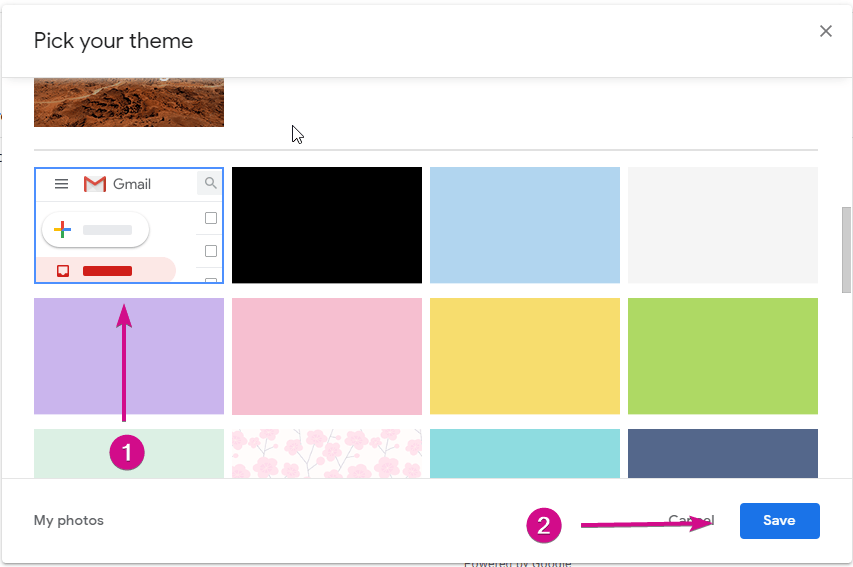
54. Choose the right Display Density
Choosing the right display density is key to sifting through emails quicker. Gmail’s default display density shows you a lot of information about your emails, including the attachments.
This can turn chaotic when you receive emails everyday. Here’s what you can do:
- Head to the gear icon at the top right corner of your inbox.
- Click Display Density.

- Try out the Comfortable setting – it takes away the information about attachments and keeps more spacing between messages.

55. Delete emails taking up storage space
Gmail has a base 15GB limit on storage space, which includes emails, Google Drive and Google+ photos. Instead of going through your inbox of thousands of emails or trashing old Docs on Google Drive, here’s a trick to help:
- In the search bar type “size:[x number]m” (make sure to include the quotes), and you’ll receive search results of all your emails that are bigger than the [x number] of megabytes that you typed in.
- Delete your biggest emails that are hogging up all the space.

56. Create your own alias-based filtering
Gmail doesn’t technically provide aliases unless you’re using Gmail to view and respond to emails sent to your own registered domain email (for example, me@jennyredfox.com). But it does allow you to set up aliases using plus signs or dots in your email address.
So “jennyredfox@gmail.com” and “jenny.redfox@gmail.com” will both go to the same inbox, as will “jennyredfox+contests@gmail.com” and “jennyredfox+money@gmail.com”. Once you’ve chosen a few aliases, set up filtering within Gmail:
- Go to the Gear Icon and select settings
- Under Filters, create Filters. You could create one that redirects all messages to “jennyredfox+contests@gmail.com” to the spam folder but stars all messages to “jennyredfox+money@gmail.com”, for example.
Or you can automatically label messages:
- Go to the Gear Icon and Settings
- Click on Labels and create a few useful labels for different things. For example you could use filters to label messages to “jenny.redfox@gmail.com” as “Family” and messages to “jennyredfox@gmail.com” as “Business”. Then all you need to do is give the appropriate version of your email address to different people and your messages will be filtered and labelled for you when they arrive.
57. Get All Emails in One Tab
Do you hate hopping tabs? Would you rather see all your emails at one place rather than in different tabs like Social and Promotional? This hack ensures that all your emails, irrespective their category are all neatly stacked up in your primary Inbox. To do this:
- Go to the settings of your Gmail and click on the Inbox tab.
- You can un-select the promotional and social checkbox. Now all your emails will be in one place!
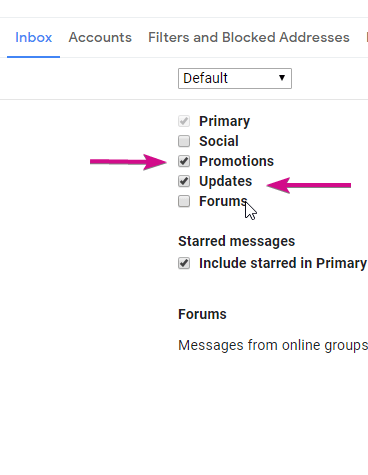
Chrome Extensions
Chrome extensions allow you to tailor Chrome’s functionality to suit your individual needs and preferences. We’ve listed some of our favourite extensions that we know will add tons of value to your daily life! Simply search for these in the Chrome Web Store and add them to your Chrome browser.
58. Schedule outgoing Emails and Receive alerts to follow up on Emails

My #1 Gmail tip is to use Boomerang or Gmail's new "Schedule send" feature. Basically, this lets you delay your replies by 1, 2 or even 24 hours. I usually delay sends by about an hour just to prevent the poor man's live chat than an email exchange can quickly become.
Brian Dean - SEO Marketing Expert at Backlinko
59. Manage your emails quickly through external notifications
Checker Plus is a free Google Chrome browser extension that helps you manage your emails quickly without opening Gmail directly. With the app, you’ll get notifications of received emails right on your browser and access it right there too. Then you’ll get options also on what to do with the email.
We love using Checker Plus but Gmail Notifier is another great option.
60. Perfect your writing
From grammar and spelling to style and tone, Grammarly helps you eliminate writing errors and find the perfect words to express yourself. Grammarly is a writing assistant that offers you comprehensive writing feedback. You’ll get suggestions from Grammarly as you write on Gmail, Twitter, LinkedIn, and nearly everywhere else. You can be confident that your writing is not only correct, but clear and concise, too!
Be sure to register your account to receive a personalized writing report each week to help you track your progress and identify improvement areas.
We are huge fans of Grammarly but can also recommend Ginger, WhiteSmoke and Hemingway as great alternatives to improve your writing.
61. Strengthen points make in Emails
Do you have a habit of using equivocating language in your email messages? Like the word “just” or phrases like “I’m no expert” or “I think”? They can undermine your message and your credibility. Just Not Sorry is an open-source extra that will put a subtle underline on such phrases so you can revise before you send. If you keep them, no one else sees the underline.
62. Send your Emails as mobile texts
Are you tired of sending emails and never getting a reply? Not everyone is as organized as you are and chances are their inbox is overflowing with unread emails!
This clever Chrome extension allows you to send a text message version of your email directly from your Gmail inbox. Yes, it may annoy the recipient when they get multiple messages from you, but will they reply quicker? Let’s hope so! The software creator says “90% of the time, a text message gets read in under 3 minutes.” Keep this in your arsenal for moments of urgency.
63. Ensure your privacy with Email encryption
FlowCrypt is an easy way to make sure any message you send from your Gmail account gets encrypted—even attachments!—using PGP encryption. FlowCrypt adds a button that lets you compose a secure message when you click it. Once you and the recipient install FlowCrypt you can send encrypted messages to anyone on your contact list, whether they have FlowCrypt or not.
If the recipient has FlowCrypt installed, messages are decrypted automatically when they’re opened on the other end. However, if they don’t have it installed, you have to create a one-time password which you should share not via email, for obvious reasons.
We can also suggest LockMagic and Mailvelope if you’d prefer something else. Snapmail, another extension, is like Snapchat for mail and only gives the recipient 60 seconds to view an encrypted mail.
64. Discover all unknown sender’s identities
Discoverly is like a private eye for Gmail. Anytime you receive an email from an unknown person, it scours the internet, revealing the person’s Twitter, Facebook, Gmail, and even LinkedIn to show you who they are. Discoverly connects all the information from these sites and puts it together for you to see the person’s mutual connections, work info and position, and it even displays their tweets.
For any information to appear, the sender must be using the email that they’ve associated with those accounts!
65. Find out more about your contacts
Similar to Discovery, Clearbit Connect can tell you more about strangers who email you. Or, maybe you’re the stranger who needs to send cold emails to others. Clearbit Connect can help you there as well, helping you find email addresses by company, rather than having to hunt them down yourself. When you compose an email, click on the Clearbit icon to search company email addresses. Or, when viewing an email, Clearbit Connect will offer up in a sidebar some information about the sender and their company. It works as advertised and is a tool our marketing team at Zapier uses often.
66. See Linkedin profiles for all your contacts
LinkedIn Sales Navigator is a browser plugin for Gmail that adds a detailed profile of email sender’s social profiles and their current work position conveniently on the Gmail sidebar.
If you’re looking to find email address in organizations for influencer outreach, I recommend using the extension Hunter.

68. Be notified of Email tracking
69. Track every Email you send
While PixelBlock is great for knowing if others have seen your emails, MailTrack promises to tell you if your message has been seen! Just look for a green double-checkmark next to a message. Click it and you’ll even see how long ago it was read. Pay $9.99 per month to remove the “Sent with Mailtrack” mark that goes on each message, and add features like tracking history and daily reports. It’s also available for Firefox, Opera, and Microsoft Edge.
70. Track an unlimited number of Emails
With the support for multiple accounts combined with an email-tracking feature, Unlimited Email Tracker is a powerful tool for every marketer. It helps you track an unlimited number of emails from an unlimited number of inboxes
![]()
71. Be the master of every attachment you send
Digify lets you manage the attachments you send to others with complete and utter control. You can send attachments, track who got them and if they were forwarded, or set an expiration date to prevent people from opening it past a specific date. You can even un-send an attachment and revoke a person’s permissions to view a file!
72. Make Gmail your default Email
There are links on the internet that do nothing except open an empty email for you to send to someone. Most browsers react to them by opening up an external email client. If you’re a Gmail user, the Send from Gmail chrome extension ensures all those “mailto:” links open a new compose message window where it should: Gmail.
Go into options to set it to use the domain name you use in GSuite, if necessary. It also puts a button on the toolbar that lets you forward anything you see online via a Gmail message.
74. Turn your Inbox into a Task Manager
Turn your inbox into an effortless task manager with the ActiveInbox Gmail plugin. It’ll cost you (after a free trial), but could be invaluable if you’re leaving things undone! This extension turns your messages into tasks, tracking and prioritizing, even turning groups of tasks into projects. Everything will get done, even if it’s just because you don’t want to waste the money.
The personal account works with one Gmail, the Pro account works with one to three accounts (even on mobile), and the team and enterprise versions kick it up a notch for a whole team.
75. Save time with canned responses
Gmail has a built-in feature called Canned Responses, which lets you create text snippets to auto-insert into messages. For even more features we suggest you use Auto Text Expander! It can insert text in any editable field in the browser, or with any web-based mail program, not just Gmail.
You can create custom keyboard shortcuts (like “sunflower”) and set it to correspond with a long block of text, even a block full of HTML code. This will save you time and prevent typos! You can import and export your shortcuts and text as needed for backup and restore to set this extension up on other PCs.
76. Save time with typing shortcuts
With the use of ProKeys, you can write full sentences using shortcuts. You need to configure the snippets, and then, you can have phrases, sentences, or whole emails written by typing just the defined shortcut. For example, you can define a shortcut “BR” for “Best regards” and “TY” for typing “Thank you“.
77. Transform Gmail into a collaborative channel
Gmelius (pronounced ‘gee-meal-ee-us’) used to be all about improving the Gmail interface but has evolved over time to have multiple uses. It has numerous features that are still free—like email tracking, scheduling messages to send later, email templates, and setting snooze/reminders on messages—but with some limitations. If you pay, you get more unlimited usage plus remote support, activity reports, and CRM integration.
The business version for teams includes collaboration tools. Every sale, support ticket, project starts with an email. Gmelius transforms email into a collaborative channel and ensures your teams get a real-time view of your company’s processes in Gmail or Slack. Give it a try for free for 14 days. Gmelius is also available as an app on iOS and Android.
78. See your Inbox only when you’re ready
Perhaps the worst distraction when you’re trying to get your email on is… your email. The Inbox When Ready extension hides the messages in your inbox until you’re ready to click a button that says Show Inbox. That way, all those pesky messages won’t get in the way of composing a new missive. The creators claim this extension will help you reclaim one hour of productivity per week. It’s free or $48 per year to use it with multiple Gmail accounts and avoid embedded signature ads.
80. Easily rename Email Subjects
Sometimes it’s the simple things that bring joy. Like being able to change the name of an email, giving it a subject line that makes a lot more sense. To do that you need an extension like Rename Email. The sender never knows you made the switch; the change is just for you (unless you reply again!). This will search on the new subject line as desired. It’s also a great way to break up a long threaded Gmail conversation, by changing the subject line however you wish.
81. Convert Google Docs to Gmail drafts
This is one of those extensions where all you need to know is in the title. You make a Google Doc. You fill it full of formatting, charts, images, whatever. Then click the button installed by the Convert Google Docs to Gmail drafts extension. Voila, you can now send it in Gmail, with all the formatting included. It may be free, but beware: you have to create an account with developer cloudHQ for it to work. But they make a lot of extensions (like Rename Subject, above) so you may already have one!
82. Create a visual board layout for Your Inbox
Prefer to organize your life Kanban board-style? The chrome extension, Drag, does just that! It changes your Inbox interface so that you can organize it into multiple boards and lists to provide context on what you need to get done for the day or in future. Your inbox can become a workspace for just you or a collaborative space for the whole team.
83. Have quick access to Gifys for Emails
84. Add private messages to BCC contacts
If you are sending an email and plan to BCC someone—that’s a “blind carbon copy” that the BCC person gets without the main recipient knowing—you can now use the Chrome extension, Murmure, for free to send a private message to the BCC. All without having to send a second, separate message to get that BCC person’s attention or send extra, specific instructions.
86. Keyboard shortcuts for Gmail will save you time
It’s not just the Delete Key that has a shortcut! Did you know there are keyboard shortcuts for most things you can do in Gmail? KeyRocket helps you learn all the shortcuts by prompting you with suggestions and shortcuts for actions you regularly do with a subtle notification when you could have used a shortcut instead of a series of mouse clicks.
You can even create your own shortcuts if that makes it easier. You’ll be a Gmail power user in no time using KeyRocket. KeyRocket is also available for Microsoft Word, Excel, PowerPoint, or Outlook from their website.

87. Redesign your Gmail interface
With the use of Simplify Gmail, you can untangle the look and feel of Gmail. The extension makes multiple tweaks to its web interface to reduce the clutter and provide a bare minimum interface. If you loved the clean interface of Inbox by Gmail, you would also like the tweaks made by Simplify Gmail.
89. Improve your productivity with Task Lists
If you’re a big ToDoist user, and use a lot of Gmail, you’re doing yourself a major disservice if you don’t install this extension. It puts the ToDoist task list tool right at your fingertips every time you access Gmail, and combines the two into a task management powerhouse. Even if you don’t already use ToDoist, adding this extension will transform your life!
90. Save articles to read later in your Inbox
This one isn’t specific to Gmail, but is great for anyone. Install Email This on Chrome and if you see any article you want to read later, click the link. The article is sent directly to your email to read later, sans all the gunk like ads. There is a free version and a Premium version with additional features.
Advanced Gmail settings
91. Learn powerful search operators to easily find Emails
Searching emails can be a pain, but with these powerful search terms you will want to use gmail to store everything. Here are the ones we consider the most useful:
- from: Specify the sender (from:amy)
- to: Specify a recipient (to:david)
- subject: Words in the subject line (subject:dinner)
- OR Messages that match multiple terms (from:amy OR from:david)
- AROUND Find messages with words near each other. Use the number to say how many words apart the words can be (holiday AROUND 10 vacation)
- “example” Add quotes to find messages in which the word you put first stays first. (“secret AROUND 25 birthday”)
- has:attachment Messages that have an attachment
- has:drive Messages that have a Google Drive, Docs, Sheets, or Slides attachment or link (has:document, has:spreadsheet, has:presentation)
- list: Messages from a mailing list (list:info@example.com)
- filename: Attachments with a certain name or file type (filename:pdf)
- ” “ Search for an exact word or phrase (“dinner and movie tonight”)
- in:anywhere Messages in any folder, including Spam and Trash (in:anywhere movie)
- is:important Search for messages that are marked as important
- after:, before:, older:, newer: Search for messages sent during a certain time period (after:2004/04/16)
- deliveredto: Search by email for delivered messages (deliveredto:username@gmail.com)
92. Learn Gmail Hotkeys that will increase your productivity
Dealing with unread emails can really take out a big chunk out of every person’s day. This can be alleviated by making use of Google’s hotkeys that both speed up and make using Gmail more comfortable.
- Archive selected message (e)
- Compose (c)
- Forward (f)
- Jump back to inbox view (u)
- Jump to newer email (k)
- Jump to next message in email thread (n)
- Jump to previous email (j)
- Jump to previous message in email thread (p)
- Mark current messages unread (Shift + u)
- Mark selected messages as important (=)
- Mute a conversation (m)
- Open keyboard shortcut help (Shift + ?)
- Reply (r)
- Reply all (a)
- Search for messages (/)
- Select a series of messages (Shift)
- Select all unread messages (Shift + 8 + u)
- Select random messages (Command)
- Send Email (Command + Enter)
Justine Jordan mentioned the archive hotkey specifically when we reached out to her:
G Suite Addons
Google has many addons that work with Gsuite. These are the addons that Google recommends. Be sure to check them out if you think they will be useful to you. We have also included some of the more popular add ons that are featured on the G Suite marketplace.
93. A CRM that seamlessly integrates with Gmail
Copper is the CRM for Google that organizes files, emails and activities across your teams and departments. All of this is managed directly in Gmail, and is recommended by Google. Worth a try if your current CRM is not working for you and you need something that a team can get on board with very quickly.
94. Move your phone system and conferencing to the Cloud
Dialpad allows you to make and receive calls, messages, video, and meetings from anywhere. Available on your desktop, tablet, or mobile devices, Dialpad empowers your team to push the limitations of what’s possible no matter where work takes them.
While there are many options for VoIP out there, Google has Dialpad as recommended with G Suite, so if your workflow is integrated well with Google, Dialpad might be worth checking out. Make sure to check out the other VoIP providers that are recommended by Google.
95. Collaborate more effectively on Team projects
Smartsheet is a software as a service offering for collaboration and work management, developed and marketed by Smartsheet Inc. It is used to assign tasks, track project progress, manage calendars, share documents, and manage other work, using a tabular user interface.

96. A professional business communications solution
97. Simple online invoicing for your business
99. Organise and manage your team effectively
Asana is an easy way for teams to plan, manage, and track their work—so you know who’s doing what by when. It’s free and simple to get started, and powerful enough to run an entire business. The integration allows you to send emails directly to your tasks and projects without having to switch between the two.
100. Quickly share files saved on the Cloud
Stop uploading files to Gmail if they’re already on the cloud. Dropbox for Gmail and Box for Gmail let you browse and attach files from those two cloud storage services, meaning you can share files or entire folders with just a couple of clicks. This is particularly useful if you’re using a Chromebook or mobile device, but even on your computer, it’s nice to have direct access to your cloud storage. It’s also possible to save email attachments directly to your cloud storage, saving you the trouble of downloading them only to re-upload so you can send a file in an email.
101. Streamline your customer support across multiple channels
Freshdesk is a multi-channel customer support solution that helps you deliver support across channels (Phone, email, chat, social, forums and more).
This is one of the more popular customer support services, helping small businesses to manage customer support across many channels. It is also recommended by Google, so its worth checking out if this is something your business needs.
102. Your business accounting made easy
Xero is a beautiful online accounting software designed for small businesses. Xero uses the best of the web and mobile to make it easy for small businesses to manage their finances anytime, anywhere.

103. A CRM and helpdesk solution combined
104. Easily start video conferencing with anyone you email
Sometimes a video or voice call can quickly settle something that would otherwise take five emails. Zoom for Gmail makes it easy to start a video conference with anyone that you’re emailing. Just open an email, click the Zoom button in the sidebar, then send the invitation over to everyone in the thread. You can start the meeting immediately or schedule it for later. It’s a handy tool, especially if everyone in your organization is using Zoom already.
105. Easily add email contents to Trello project boards and lists
Want to quickly send the contents of an email over to Trello? Trello for Gmail makes it easy. Just open an email, click the Trello icon in the sidebar, then pick a destination board and list. By default the subject will be the card’s name and the email body will become the description, but you can edit everything before sending it over to Trello. It’s a simple integration, sure, but a useful one for project management.
107. Easily store notes & attachments from Emails
Evernote is where you can store everything from personal moments to business projects, and know they’re always safe, always secure, and ready whenever you need them.
With the focus on ease of use, the Evernote Gmail plugin allows you to turn emails and attachments into notes that you can easily save and share, and have synced between all your devices.
108. Track your Emails with Whatsapp style checkmarks
Mailtrack allows emails to be tracked in a similar way to messaging apps like WhatsApp. Once you have it installed your emails will have either 1 or 2 check marks.
(✓) means that your email has been sent, but not opened.
(✓✓) means that your email has been opened.
It’s that simple. It’s incredibly useful when following up on clients, and you want to know if they are even receiving your emails.

This was Felix Norton’s number 1 tip when it came to tips for Gmail users:

You can get insane insights from your email correspondence by tracking who's read your email. I use it to see if I should follow up with someone via a call because they haven't seen my mail. Or even as a hack to see if someone is considering a mail, because they've opened and re-read it 7 times!
Felix Norton - Managing Director at Woww Digital
Other Gmail Features
109. Change the default text of your Gmail
Whether you are tired of the default text or are just looking to personalise your Gmail, changing the default text can make a massive difference.
- Go to settings
- Under the General tab, you will see a text box called default text style
- Change the text in this box to display how you would like it to be in emails.
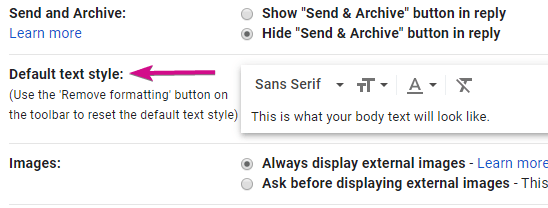
110. Enable or disable Email nudges
Have you noticed Gmail has started pointing out emails you need to reply to? Or emails that you are still waiting on a reply? These are called nudges. Whether you find them useful or anxiety inducing, you can enable or disable them like this:
- Go to settings.
- Under the general tab, you can enable/disable email nudges
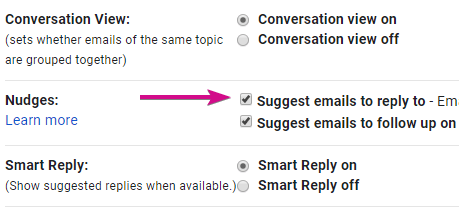
111. Enable auto-advance to get through Emails faster
Do you find yourself managing a large amount of emails regularly? This can be made far easier with the Auto-Advance feature. Whenever you delete, archive, sleep or mute a conversation, it automatically moves on to the next email.
- Go to settings
- Head to the Advanced tab
- Look for Auto-Advance and enable it

Making the most of the Google products that integrate with G Suite/Gmail
You can use Google products, like Gmail or Calendar, in the same window on your computer. This way, you can keep track of important info without switching between tabs.
112. Add attachments easily from Google Drive
Having a Gmail or G Suite Account gives you access to a range of other apps, including Google Drive, and along with it, Google Docs, Google Sheets, and other document processing apps. Using these apps will allow you to share and collaborate easily with your team.
You’ll also have the option to attach Google Drive files easily in an open Gmail message. Here’s how you can do that:
- Compose an email
- At the bottom of the email, look for the Google Drive icon.
- Click it and select the files you want to send.

113. Take notes with Google Keep
Google Keep is Google’s note taking app that allows you to quickly jot down ideas, and have these notes synced across all your devices. It’s a note taking system that integrates well with the whole google ecosystem so it’s worth trying it out. You can install it with the plus sign in the right bar of gmail. Click the arrow if you don’t see the bar immediately.
- Open the sidebar while you have an email selected.
- Click on the Google Keep logo.
- Click “Take a note”, and the currently selected email will be attached to the note.
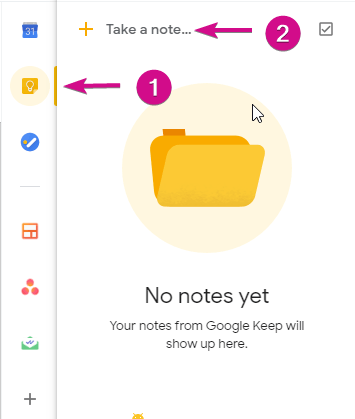
114. Manage your life with Google Calendar Events
Google Calendar is the most used desktop Calendar, and for good reason. It has a solid feature set, easy to use UI and integrates with the tools we use the most. After you have installed Google calendar via the sidebar in Gmail, you will have some cool new options to integrate the two. Try creating an event from inside gmail:
- Click the Calendar icon on the far right bar.
- Select create event
- Add guests and a time and you all set
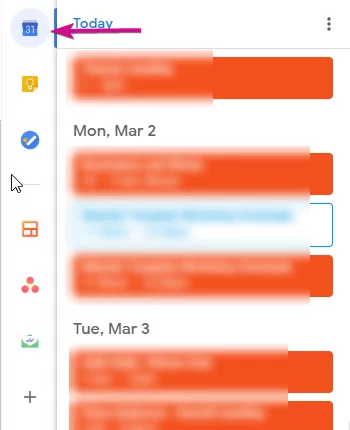
115. Track and store your data with Google Vault
Keep track of all your data. Retain, search and export your organisation’s data from select apps with Vault for G Suite Business and Enterprise editions. Google Vault keeps everything stored for you, even in cases where information is lost suddenly.
This doesn’t integrate directly with Gmail, rather it stores all the data that was associated with an entire Google account. This does include all emails however, so it comes in useful with organisations that want to retain all critical information through employee turnover.
116. Stay organised using Google Tasks
Stay organized and make sure you complete everything on your email to-do list by using Tasks in Gmail. Simply open up an important email that you need to get to later and click on the More button > Add to Tasks. Then your Task window will pop open on the side of your screen where you can see all of your tasks and you have the ability to check them off once they’re complete.
Utilizing the tasks feature in Gmail will make sure your most important emails won’t get lost in your inbox again and help to ensure that you stay on track with your messages.
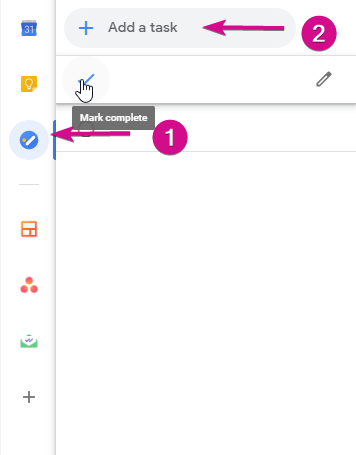
117. Make and receive payments with Google Pay
Did you know you can get paid and send money through Gmail? You must create a Google Wallet account, which includes your banking info, and enable the setting “Send money using Gmail.” The recipient must also have Google Wallet.
After composing a message, click on the dollar sign icon at the bottom of the message and you’ll be presented the option to send money to your email recipient. To get someone to send you money, select “Request” instead!
118. Use Google Contacts to store and group your contacts
Google contacts is a software that has tonnes of useful features that many people don’t pay enough attention to. It stores all contacts across all devices and allows you to create groups that you can send mass emails to. It also allows you to share contacts and contact groups among team members in your organisation. This can save headaches trying to get a clients contact details from an out-of-office team member.
The easiest way to get to Google contacts is through the Google Menu. You might need to scroll down a few notches to find it.
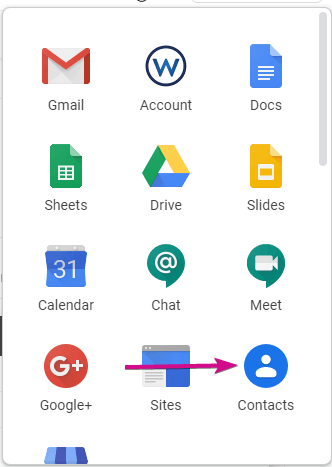
External App Integrations
119. Manage all of your Email subscriptions in one place
Are you tired of receiving an enormous number of emails from mailing lists you’ve subscribed to? After a while, this can get completely out of hand and would take far too long to unsubscribe to all of them manually.
Unroll.Me will show you a list of all of your subscription emails, so you can instantly unsubscribe from what you don’t want.
Gmail Automations
120. Automate your emails to create Labels And Tasks
Zapier is a web-automation service that automates emails to create labels, tasks, etc. It works by setting up a series of triggers and actions. For example, you might set up a text message alert (action) for when you receive a new email (trigger). Sync to every web app you use, and automate tedious tasks. Free up your mind and your time for a bigger, better deal.
121. Manage shared Inboxes through a collaborative platform
Hiver is an email collaboration platform that helps you manage shared inboxes right from Gmail. It enhances your Gmail to work for teams like customer support or any team that collaborates on Email. You can share labels with other team members, as well as hit snooze on emails, scheduling them to pop back up at the top of our inbox at a scheduled time. It’s ideal for delegating and tracking emails, along with collaborating on notes, templates, and contacts.

